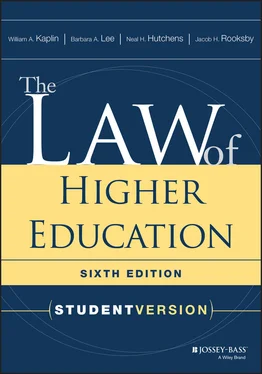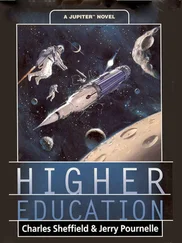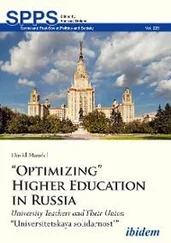As further support for these judicial hands-off attitudes, higher education institutions also enjoyed immunity from a broad range of lawsuits alleging negligenceor other torts. For public institutions, this protection arose from the governmental immunitydoctrine, which shielded state and local governments and their instrumentalities from legal liability for their sovereign acts. For private institutions, a comparable result was reached under the charitable immunitydoctrine, which shielded charitable organizations from legal liability that would divert their funds from the purposes for which they were intended.
In the latter half of the twentieth century, however, events and changing circumstances worked a revolution in the relationship between academia and the law. Changes in the composition of student bodies and faculties, growth in the numbers and diversity of institutions and educational programs, advances in technology, greater dependence of both private and public institutions on federal financial assistance and research support, increases in study abroad programs and joint ventures between American institutions and those in other countries, and expanded relationships with private sector commercial entities dramatically altered the legal and policy landscape for colleges and universities. The civil rights and student rights movements contributed to the legal demands on institutions, as individuals and groups claimed new rights and brought new challenges. Demands for accountability by federal and state governments and private donors also spawned new challenges.
As a result of these developments, the federal government and state governments became heavily involved in postsecondary education, creating many new legal requirements and new forums for raising legal challenges. Students, faculty, other employees, and outsiders became more willing and more able to sue postsecondary institutions and their officials (see Section 1.1). Courts became more willing to entertain such suits on their merits and to offer relief from certain institutional actions. In short, by the end of the twentieth century, higher education no longer enjoyed much of the judicial and legislative deference it once knew.
The latter years of the twentieth century and the first two decades of the twenty-first witnessed increasing conflict on campus relating to diversity of ideas, racial and ethnic identities, sexual orientation, gender concerns, and other matters concerning cultural diversity. As the twenty-first century progressed, there was no lessening of the pace of change or the impact of new societal developments on higher education. Remnants, or new incarnations, of most trends from the 1980s and 1990s (and some earlier ones) continued to occupy the attention of institutional officers, counsel, and faculty; and new trends and developments continued to emerge. The globalization, commercialization, “technologization,” and diversification of higher education continued to be predominant, overarching trends affecting higher education in numerous ways.
In all, postsecondary education remains a dynamic enterprise in the twenty-first century, but institutions face several significant challenges. Societal developments and technological breakthroughs continue to be mirrored in the issues, conflicts, and litigation that colleges and universities now face. Virtually every area of the law now applies to institutions of higher education. The challenge for the law is, as it has been, to keep pace with higher education by maintaining a dynamism that is sensitive to institutions' evolving missions and the varying conflicts that institutions confront. And the challenge for higher education continues to be to understand and respond constructively to changes and growth in the law while maintaining focus on multiple purposes and constituencies.
Section 1.3. The Governance of Higher Education
1.3.1 Basic concepts and distinctions. Governancerefers to the structures and processes by which higher education institutions and systems are governed in their day-to-day operations as well as their longer-range policy making. Governance encompasses (1) the organizational structures of individual institutions and (in the public sector) of statewide systems of higher education; (2) the delineation and allocation of decision-making authority within these organizational structures; (3) the processes by which decisions are made; and (4) the processes by which, and forums within which, decisions may be challenged.
Higher education governance can be divided into two categories: internal governance and external governance. “Internal governance” refers to the structures and processes by which an institution governs itself. “External governance” refers to the structures and processes by which outside entities (that is, entities external to the institution itself) play a role in the governance of institutional affairs. Internal governance usually involves “internal” sources of law (see Section 1.4.3of this book); and external governance generally involves “external” sources of law (see Section 1.4.2). In turn, external governance can be further divided into two subcategories: public external governance and private external governance. “Public external governance” refers to the structures and processes by which the federal government (see Section 11.3), state governments (see Section 11.2), and local governments (see Section 11.1) participate in the governance of higher education. “Private external governance” refers to the structures and processes by which private associations and organizations participate in the governance of higher education. Major examples of such external private entities include accrediting agencies (see Section 12.1.2), athletic associations and conferences (see Section 12.1.3), the American Association of University Professors, and other higher education associations. Other examples include national employee unions with “locals” or chapters at individual institutions (see Sections 4.3and 5.3); outside commercial, research, public service, or other entities with which institutions may affiliate; and public interest and lobbying organizations that support particular causes.
The governance structures and processes for higher education, both internal and external, differ markedly from those for elementary and secondary education. Similarly, the structures and processes for public higher education differ from those for private higher education. These variations between public and private institutions exist in part because they are created in different ways, have different missions, and draw their authority to operate from different sources (see generally Section 3.1), and in part because the federal Constitution's and state constitutions' rights clauses apply directly to public institutions and impose duties on them that these clauses do not impose on private institutions (see generally Section 1.5below).
Furthermore, the governance structures and processes for private secular institutions differ from those for private religious institutions. These variations exist in part because religious institutions have different origins and sponsorship, and different missions, than private secular institutions, and in part because the federal First Amendment and comparable state constitutional provisions and laws afford religious institutions an extra measure of autonomy from government regulations, beyond that of private secular institutions, and also limit their eligibility to receive government support (see generally Section 1.6below).
Governance structures and processes provide the legal and administrative framework within which higher education problems and disputes arise. They also provide the framework within which parties seek to resolve problems and disputes (see, for example, Section 2.3) and institutions seek to prevent or curtail problems and disputes by engaging in legal and policy planning (see Section 1.7). In some circumstances, governance structures and processes may themselves create problems or become the focus of disputes. Internal disputes (often turf battles) may erupt between various constituencies within the institution—for example, a dispute over administrators' authority to change student grades given by faculty members or to establish international satellite campuses. External governance disputes may erupt between an institution and an outside entity—for example, a dispute over a state board of education's authority to approve or terminate certain academic programs at a state institution, or a dispute over an athletic association's charges of irregularities in an institution's intercollegiate basketball program. Such disputes may spawn major legal issues about governance structures and processes that are played out in the courts. (See Section 6.2.3 for examples concerning internal governance and Sections 11.2and 12.1for examples concerning external governance.) Whether a problem or dispute centers on governance, or governance simply provides the framework, a full appreciation of the problem or dispute and the institution's capacity for addressing it effectively requires a firm grasp of the pertinent governance structures and processes.
Читать дальше












